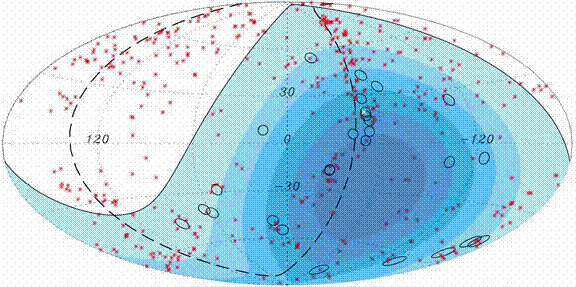The observed anisotropy of arrival directions of incoming cosmic ray particles with energy above 6 . 1019 eV is one of the most important results of the Pierre Auger Observatory. Such particles are very rare and during 50 years of their measurement at different observatories only few tens of them were detected. Because of their extremely large energy, that is many orders of magnitude larger than what humans can produce in laboratories, their existence is very puzzling and no existing astrophysical theory can fully explain their production. In 2007, the Pierre Auger Observatory made a significant step towards understanding of nature of these particles. It was shown that these cosmic rays do not arrive uniformly from all directions on the sky, but specific directions are preferred. The best statistical agreement is obtained with the positions of nearby active galactic nuclei up to the distance of 300 million light years from the Earth.
The discovery of this kind of anisotropy leads to conclusion that sources of these particle should be searched for within the group of usual and known astrophysical objects, because most of other exotic scenarios needs uniform distribution of arrival directions on the sky that is now ruled out with a given high confidence level.

Arrival directions of incoming cosmic rays as measured at the Pierre Auger Observatory (black circles) and positions of known active galactic nuclei (red dots) up to the distance of 75 Megaparsecs (i.e. ca 300 million light years).
Scientists from the department of astroparticle physics together with colleagues from Joint Laboratory of Optics of Palacky University and Institute of Physics significantly contributed to the design and the construction of mirror segments for 15 out of 27 telescopes of the fluorescence detector. Contrary to the surface detector, which measures shower profile on the ground, detection system of fluorescence telescopes allows for measurement of longitudinal profile of cosmic ray shower as it develops in the atmosphere. A related activity of the group concerns the measurement of the fluorescence yield, which precise knowledge is essential for good energy reconstruction of incoming cosmic rays. Also the monitoring of the atmosphere is essential for the reduction of systematic uncertainties caused by clouds or aerosols present in the atmosphere. To this topic the group has contributed e.g. by the construction and the operation of robotic telescope FRAM, which studies atmospheric extinction using measurement of immediate brightnesses of standard stars. We participate also on the measurements at the Observatory in Argentina, on the data analysis and on the Monte Carlo simulations of cosmic ray showers in the grid environment. Another topic more related to the observed anisotropy is the study of influence of magnetic fields on the propagation of cosmic ray particles in the universe.
BibliographyCopyright © 2008-2010, Fyzikální ústav AV ČR, v. v. i.